"Die Kunst der Fuge" with Il Gusto Barocco
In September 2024 I was part of another very interesting production of Il Gusto Barocco, the ensemble founded and led by keyboard player and conductor Jörg Halubek. This group approaches Baroque music in a both fresh and knowledgeable way and is never afraid to experiment with forgotten repertoire or unusual, though evidence-based, elements of performance practice.
In this case, the repertoire was not at all forgotten, but we recorded the slightly lesser-known version of the piece, which is based on the handwriting and does not include some movements that appear in the first edition.
As the “Kunst der Fuge” does not have a fixed instrumentation (if one doesn’t assume that Bach always writes for a keyboard instrument if not indicated otherwise), this piece can be performed by all sorts of formations, from a saxophone quartet to a full orchestra. Personally, I am not even sure if this piece is supposed to be performed at all, and if this collection of fuges and canons is not just an exercise in different kinds of counterpount or even a piece of “conceptual art”, but I like the idea that each piece can be brought to life with an instrumentation that fits its character - in spite of the theoretical nature of the piece, each momevement is touching in its own way.
For our version, Il Gusto Barocco used a wide range of instruments that basically represents everything Bach had at his disposal: (single) strings, viola da gamba, oboe, oboe da caccia and bassoon, transverse flutes, a cornetto and trombone choir, harpsichord, and a church organ. The orchestration followed the way Bach employs these instruments in his work, with the woodwinds doubling the strings in tutti pieces (the flutes often playing the tenor in a higher octave), the cornetto and trombones doubling the organ in a “vocal” 4-part fugue, while the harpsichord and smaller instrument choirs performed the more virtuosic canons. We even explored the possibility of dividing a solo voice or solo passages amongst several different instruments (such as violin and oboe) to create a different way of bringing out the counterpoint.
We were lucky to do this recording in the most perfect and remarkable place: on the gallery of the original Silbermann organ in the Friedenskirche in Ponitz (Germany), built as a whole in 1732-1734.


